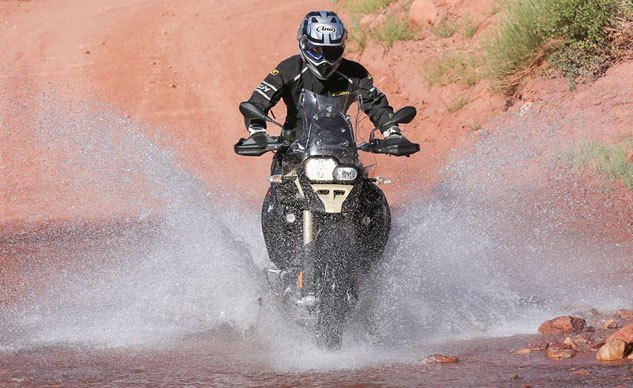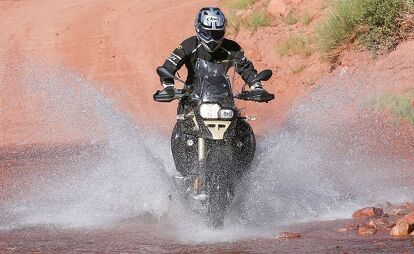2014 BMW F800GS Adventure Review
BMW’s F800GS has been a tidier-sized adventure-touring rig since its introduction in 2008, offering most of what its iconic big brother, the R1200GS, has in a smaller, lighter and cheaper package.
But for hardcore adventure riders, the 800GS fell a mite short in terms of its battle-readiness and, perhaps most important, its fuel range. Using an underseat fuel tank limited its volume to just 4.2 gallons, which, if you’re taking the long way around, might be a gallon or two short of adequate when exploring, say, the Baja peninsula.
Enter the new F800GS Adventure, which has been endowed with more off-road worthiness, additional touring features, and a considerable 6.3 gallons of fuel capacity. This expands its range by a significant 100 miles.
Its rear subframe was strengthened to support the additional fuel load, and the GSA comes standard with aluminum saddlebag mounts that will help cushion the inevitable thuds that occur when venturing well off the beaten tracks, whether or not you order the optional aluminum saddlebags. Standard equipment includes tubular crash bars to protect the engine and a plastic sump guard.
VIEW: Read our review of the BMW F800GS
Touring comfort is also enhanced by a larger windscreen, standard hand guards and a cushier color-matched two-tone seat. Wind protection is augmented by larger bodywork around the radiator area. The GSA’s extra accoutrements add up to a 20-pound weight gain over the GS, rising to 505 pounds when fully fueled.
Moab, Utah
BMW picked a spectacular setting to test its newest Adventure model – the same location used when the 800GS was originally launched in 2008. Not only is the scenery around Moab riveting, so was the route mapped out for us. It consisted of mostly unpaved sections ranging from sweeping fire roads to gnarly and loose rocky trails – ideal testing grounds for a bike with Adventure in its name.
The Adventure is based, of course, on the regular F800GS, so the GSA naturally carries on most of its bones. Stylistically, the GSA differs by a larger beak/fender, expanded shrouds in front of a rider’s knees and the fatter ass end from the wider fuel tank.
Thicker seat padding lifts its height from 34.6 to 35.0 inches, which will discourage riders short on inseam length. Stubby riders will want to opt for the optional-at-no-cost low seat set at 33.9 inches. A height-adjustable seat like Triumph’s Tiger 800XC would’ve been a nice addition. Suspension travel remains static, with 9.1 inches available from the non-adjustable inverted fork and 8.5 inches of support from the single shock out back.
Both hand levers are adjustable for reach to accommodate various digit sizes, and the rear brake pedal, reinforced on the GSA, includes a trick new adjustment feature. A standard serrated pedal is augmented by a flip-up/down serrated pedal that does a good job of accommodating a rider’s foot when standing. New and beefy serrated footpegs are wide to provide excellent support when standing. Rubber inserts bolt in to damp vibration when you’re not slinging mud.
The F800’s 798cc parallel-Twin engine remains unchanged in the GSA, so it should crank out the same 81 horses and 57 ft-lb of torque as measured during our 2011 comparo with the Triumph Tiger 800. The engine produces a terrific spread of power, able to tractor away from as low as just 2000 rpm, but its vertical-Twin architecture continues its reputation as a vibey powerplant.
On the plus side, the F800’s throttle response is impeccably manageable whether on the street or in the dirt, assisted nicely by an easy-to-modulate clutch. The workmanlike motor can tolerate speeds in second gear from just above 10 mph all the way to 70 mph, exhibiting good pull and easily controllable traction management. The engine is very effective but isn’t pleasing or charismatic – it’s very coarse.
COMPETITION: Read our review of the Triumph Tiger 800
The GSA boasts two ride modes: Road and Enduro. It’s the Enduro setting that is most notable in that it uses off-road-specific tuning for the available traction control (ASC) and standard ABS which got tested early during our ride. While ASC in Road mode is useless in the dirt, intervening constantly, its tuning in Enduro mode allows plenty of tail-happy sliding. Even the hardcore dirt riders in our group appreciated its moderate intervention and seldom switched it off, which can be done on the fly.
Disabling ABS requires the bike be stopped, but it, like ASC, isn’t overly intrusive in the dirt. Although it doesn’t have the sophisticated Enduro Pro mode experienced on the new liquid-cooled R1200GS tested a few months ago, which disables ABS on the rear brake, the 800GSA’s system isn’t overly meddling.
On our dirt route, I got surprised by a downhill, off-camber corner, coming in too hot. But thanks to the ABS, I was able to use a considerable amount of front brake to get slowed, barely, in time. Without ABS, I may have tucked the front in a panic to reduce my speed. In all environments, the 300mm front rotors with two-piston calipers offered both strength and sensitivity via braided steel lines.
The F800GS has always been much easier to manage off-road than the tank-like R1200GS, and that continues with the 800GSA. It’s considerably easier to navigate tricky, technical sections than the big GS, and it’s nice and narrow to allow moving your body back and forth and side to side. In addition, its conventional suspension works better over off-road bumps than the R1200GS’s Telelever/Paralever combo.
Our test bikes were outfitted with BMW’s optional aluminum bash plate that guards the oil filter and exhaust header pipes, which we’d consider a requirement if you plan to navigate rocky trails. Also optional, but at no cost, are Continental TKC80 knobby tires instead of the standard 80/20 Michelin Anakee llls. The Contis (90/90-21 front; 150/70-17 rear) aren’t as secure on pavement, but they’re the hot ticket in off-road use.
Head Out On the Highway
After kicking up dust for a day, I went the extra couple hundred miles to evaluate the 800GSA’s touring capabilities by riding to Colorado to help MO’s Troy Siahaan cover the Pikes Peak International Hill Climb in which he was racing a Zero electric motorcycle in the historic event. A variety of highway droning and mountain pass passing gave a fuller idea of what the GSA is like as a traveling companion.
VIEW: Read our comparison of the BMW F800GS and Triumph Tiger 800XC
I was grateful to have BMW’s aluminum side cases in which to hold all my stuff. The panniers are boxy and sturdy with nice welds, boasting 82 liters of capacity. The left bag narrows at its bottom to clear the muffler. A 32-liter aluminum top case is available for those who refuse to pack light.
Highway travel reveals the F800GS Adventure’s virtuous touring comfort. Ergonomics are about ideal, even with the handlebar rotated slightly forward for our off-road riding. Ample legroom is a benefit of its tall saddle, and support from the seat suited my butt quite well.
The Adventure’s windscreen is remarkably effective at diverting air up and around its rider. Shorter pilots like myself (5-foot-8) will enjoy quiet airflow. Steering effort that is quite light at slower speeds becomes heavier at freeway velocities due to the gyroscopic effect of its 21-inch front wheel/tire.
The long-travel suspension that works so well in the dirt also excels on the road, providing a ride that is as smooth as it gets. Our test unit was equipped with ESA, BMW’s electronic suspension adjustment, but it’s a rudimentary system compared to the R1200GS’s.
Like the 2013 F800GT we recently tested, ESA controls only rear rebound damping, from a rather loose Comfort setting to a buttoned-down Sport option. As could be expected, the Normal setting is most often preferable. The only other suspension adjustment is for rear preload set by an easy-to-adjust hydraulic knob.
The only impediment to long-term comfort is its relentlessly buzzy engine. Tingles are felt at nearly all points across the inline-Twin’s rev range. The insistent vibes are, at least, annoying, but I don’t find them to be debilitating – my hands never buzzed into numbness.
The GSA’s gauge cluster contains loads of info, such as ambient temp, range-to-empty, trip duration, ride modes and, of course, a clock, fuel gauge and dual tripmeters. However, legibility would be improved by a larger LCD info screen. On a related note, the F800’s analog speedo has too many numerals crammed together for quick and accurate speed assessments – this bike does not need 160 mph of range!
Conclusion
With the new Adventure model, BMW has succeeded in its goal of enhancing the touring and off-road capabilities of the F800GS. It’s a highly effective tool for covering multi-state trips, leaving open the possibilities of exploring unpaved roads that can make tours truly adventurous.
Like most well-engineered and adaptable machinery, pricing can be an issue. The base GSA, which includes a 12V accessory socket and luggage rack, retails for $13,550. Upgrade to the “Premium Package” for desirable elements such as ASC, heated grips and a centerstand, and now we’re talking $14,350. Add another $645 for the loaded version that adds LED fog lights and ESA. All GSAs enjoy an enviable 3-year, 36,000-mile warranty.
Those are, admittedly, big numbers on the price tag, and there are a few options of cheaper adventure-touring machines. But none provide quite the balance of off-road nimbleness and capabilities along with its long-range comfort and touring proficiencies.
+ Highs
- Able to venture where some bigger A-Ts fear to tread
- Feature-laden and customizable with options
- High range and comfort
– Sighs
- Pricey, especially with desirable options
- Engine buzz that just won’t quit
- Instruments need an update
More by Kevin Duke




















































Comments
Join the conversation
F800 is my deram bike ,i want buy one when i get enough money.
That's a lot of money for a Chino-German bike...A big heavy one.